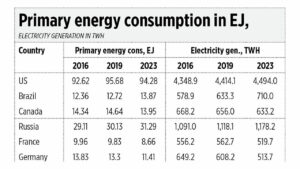US President Donald J. Trump issued many executive orders (EO) on the first day of his second term. Below are some of those EOs that are related to energy and climate.
1. Putting America First in International Environmental Agreements. Section 3-a provides that the US “shall immediately submit formal written notification of the United States’ withdrawal from the Paris Agreement under the United Nations Framework Convention on Climate Change… The US International Climate Finance Plan is revoked and rescinded immediately.”
2. Declaring a National Energy Emergency. It provides for emergency approvals of permits, expediting the delivery of energy infrastructure, coordinated infrastructure assistance, and more.
3. Unleashing American Energy. Section 2 provides to “…eliminate the ‘electric vehicle (EV) mandate’ and promote true consumer choice… terminating, where appropriate, state emissions waivers that function to limit sales of gasoline-powered automobiles; and by considering the elimination of unfair subsidies and other ill-conceived government-imposed market distortions…”
Sec. 5 provides for “Unleashing Energy Dominance through Efficient Permitting.” Sec. 7. is “Terminating the Green New Deal” and “All agencies shall immediately pause the disbursement of funds appropriated through the Inflation Reduction Act of 2022 (Public Law 117-169) or the Infrastructure Investment and Jobs Act (Public Law 117-58), including but not limited to funds for electric vehicle charging stations.” And Sec. 9 is “Restoring America’s Mineral Dominance.”
4. Unleashing Alaska’s Extraordinary Resource Potential. Sec. 2 provides to “expedite the permitting and leasing of energy and natural resource projects in Alaska; and prioritize the development of Alaska’s liquefied natural gas (LNG) potential, including the sale and transportation of Alaskan LNG to other regions of the United States and allied nations.” Sec. 3 provides to “rescind the cancellation of any leases within the Arctic National Wildlife Refuge.”
I checked some of the US’ energy numbers and compared them to the G7 nations and the BRICS+ member-countries including Brazil, Russia, India, China, Indonesia, Iran, and the United Arab Emirates (UAE). I chose to compare the years 2016 (the end of the Obama administration), 2019 (before the COVID lockdown under Trump), and 2023 (the latest available data under Biden) for comparison. Two trends or patterns are seen.
1. In primary energy consumption expressed in exajoules (EJ), the US was nearly flat, consuming 92.6 EJ in 2016 then barely rising to 94.3 EJ in 2023. All other members of G7 — Canada, Japan, the UK, France, Germany, and Italy — had declining numbers. In contrast, all the BRICS+ countries had rising numbers.
2. In total electricity generation from different sources, the US again saw very little expansion — nearly flat — and the six other members of G7 had declining numbers. In contrast, BRICS+ countries’ numbers were rising (see the table).
Compared to its ASEAN neighbors, the Philippines’ primary energy consumption and electricity generation were very small, yet we are being bullied by the climate establishment to disallow the building of any new coal plants, which soon might extend to gas plants demonization. We should ignore this unwise lobby. We should focus on building more large conventional thermal power plants to provide us with a bigger supply of electricity at competitive prices.
OPPORTUNITIES FOR PHLIn 2023, natural gas contributed 14% of the total power generation of the country, coal contributed 62%, and the rest came mainly from geothermal and big hydro, while intermittent renewable sources like solar and wind contributed below 6%.
The US is the world’s largest LNG exporter. In 2016 or Obama’s last year, the US exported only four billion cubic meters (bcm) of LNG. By 2017 or Trump’s first year, it jumped to 17 bcm, and increased to 61.3 bcm by 2020. In 2023, the US’ LNG exports reached 114 bcm, largely due to exports to Europe as many countries there were avoiding getting LNG from Russia.
Trump’s “drill-baby-drill” policy, particularly exporting more LNG to its Asian allies and trade partners would mean stable LNG prices at low levels. The Philippines will benefit from this.
Currently there are five existing or under construction LNG power plants in the country, mostly located in Batangas. The biggest operational plant is Ilijan or the South Premier Power Corp. (SPPC), with a dependable capacity of 1,200 MW. Soon to be the biggest power plant in the country is Excellent Energy Resources, Inc. (EERI) with a capacity of 1,760 MW (440 MW for each of its four units).
Both Ilijan and EERI are owned by San Miguel Global Power (SMGP) — but with the approved partnership with Meralco Power Gen Corp. (MGen) and Aboitiz Power Corp. (AP) through Chromite Gas Holdings, Inc. (CGHI), these two LNG plants will soon be owned and operated by three of the largest energy conglomerates in the country.
So, with competition on LNG exports between the US and some Asia-Pacific nations like Australia, Indonesia, and Malaysia, plus having modern and efficient gas plants would mean cheaper power or electricity for the Philippines. This will help bring down overall consumer prices, and lower the inflation rate for 2025 and beyond.
LECTURE AND REUNIONMeanwhile the UP School of Economics Program in Development Economics Alumni Association will hold a homecoming on Feb. 7 at the school. Immediately before the reunion is the Ruperto P. Alonzo (RPA) annual memorial lecture which will be about energy.
Bienvenido S. Oplas, Jr. is the president of Bienvenido S. Oplas, Jr. Research Consultancy Services, and Minimal Government Thinkers. He is an international fellow of the Tholos Foundation.
minimalgovernment@gmail.com

